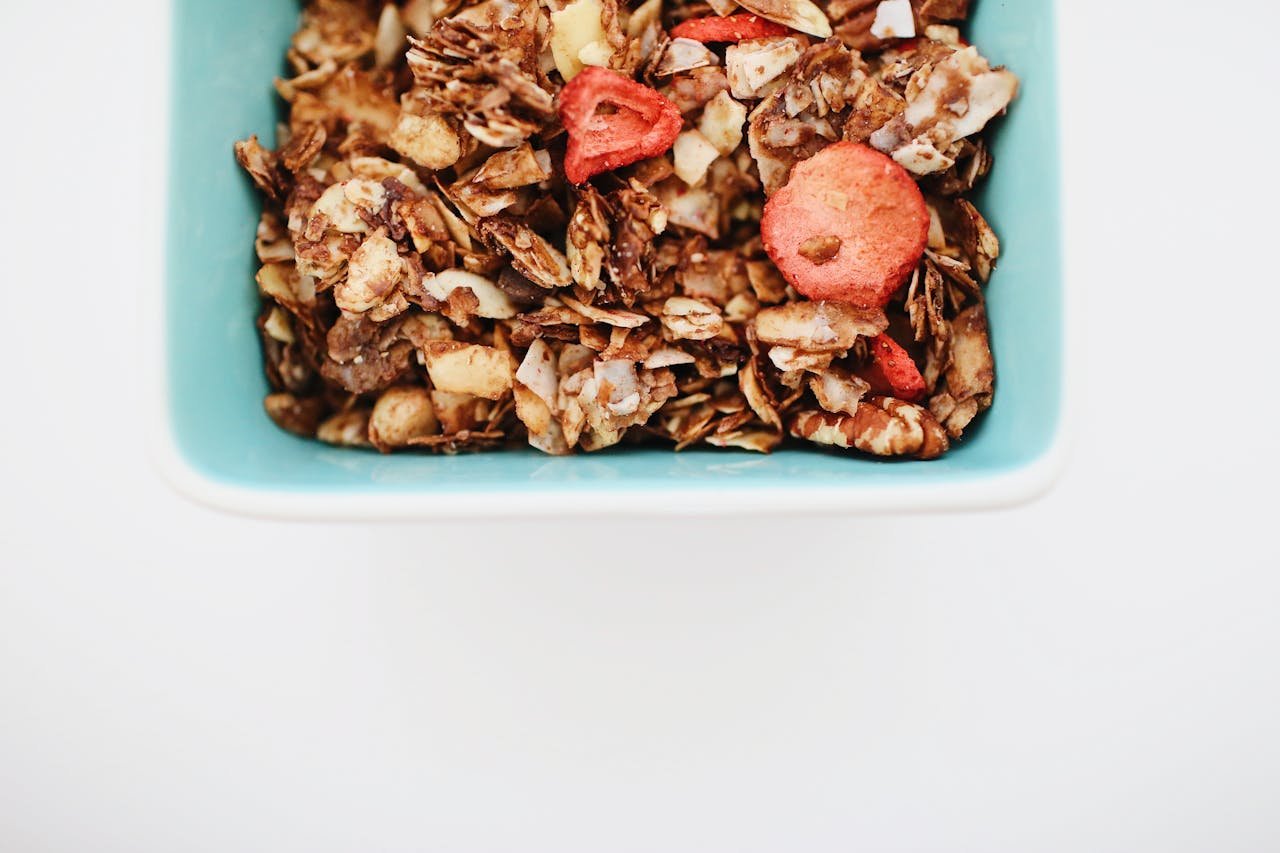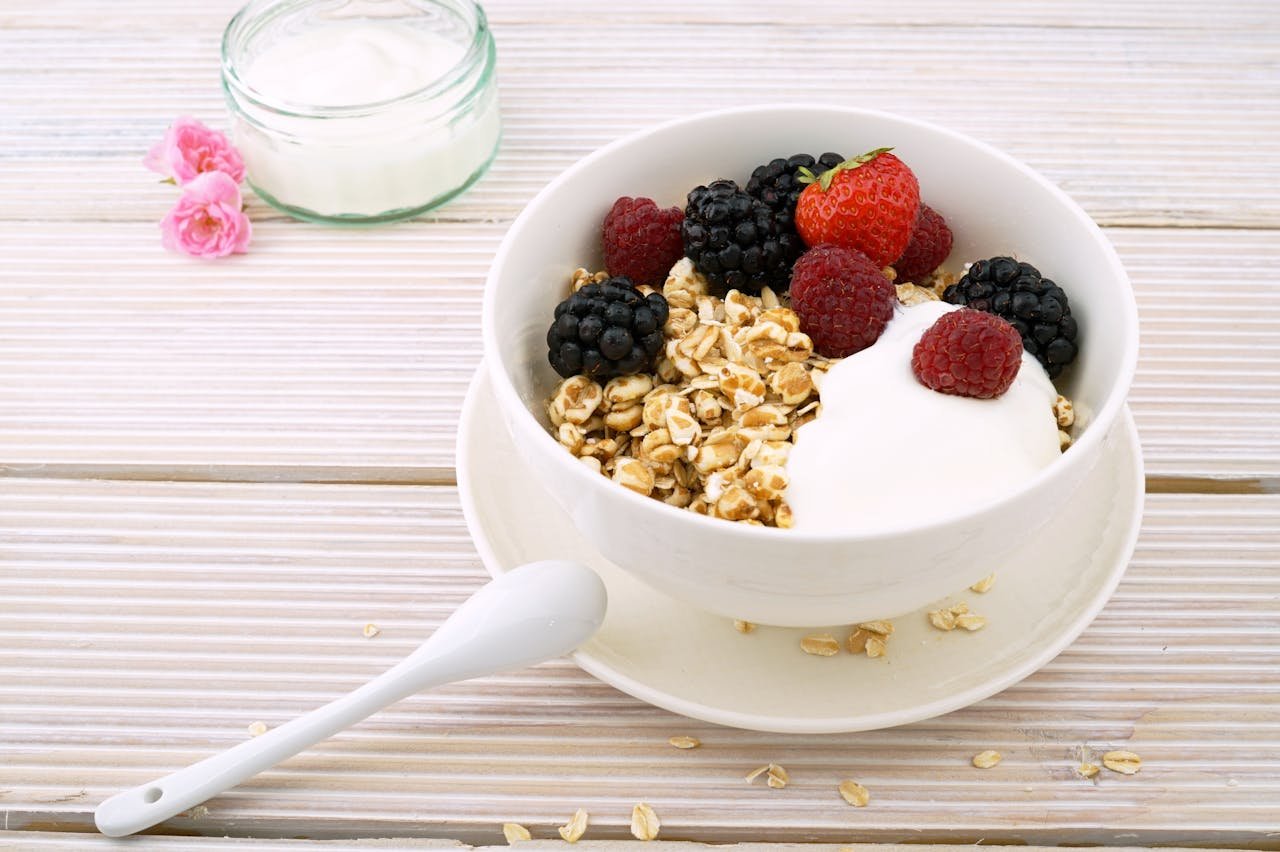Looking for a delicious, yet nutritious breakfast or snack? Granola is among the best options.
It is easy to prepare, does not require many ingredients, can be stored, and provides you with all the nutrients and calories your body needs.
Why is it so healthy? In the following article, we explain why, supported by scientific evidence, and we explain step by step how to prepare it.
What is granola?
The word granola is used to refer to a sweetened mixture of rolled oats, nuts, honey, and, occasionally, dried fruits such as raisins and spices. It can be accompanied by yogurt, chocolate, or fresh fruits (for example, cherries).
To understand the history of granola, we must talk about granola. The latter was one of the first cereals manufactured and promoted as a nutritious breakfast, by Dr. James Caleb Jackson in 1863.
In 1881, Dr. John Harvey Kellogg developed his variant of granular, whose ingredients would be almost the same. This prompted a lawsuit by Dr. Jackson, forcing Dr. Kellogg to change the name of his new product to granola.
Since then, especially after the 1960s, granola has become popular as a nutritious breakfast composed of cereals loaded with vitamins and minerals.
Health benefits of granola
Granola, especially homemade, contains a plethora of benefits as it is made up of nutritious ingredients.
Below we mention some of the most important ones.
1. Strengthens the immune system
The dietary fiber offered by granola supports the immune system, particularly the gut-associated lymphoid tissue (GALT).
It is a cluster of immune cells located throughout the intestine.
Multiple studies have observed that the consumption of fermentable fiber, such as cellulose, inulin, and oligofructose, is associated with an elevation in the levels of type A antibodies, CD4, CD8 T lymphocytes, macrophages, and antitumor function.
It is hypothesized that the prebiotic effect of fiber increases the proportion of healthy bacteria. Some of the latter can cross the epithelial barrier of the intestine, interact with recumbent immune cells, and activate them.
2. Regulates blood sugar level
The fermentable fiber in granola is associated with changes in the structuring of intestinal cells, favoring the release of insulin and other similar peptides, and is also associated with an increase in glucose transport and homeostasis.
Studies Experimental studies show that the consumption of a diet rich in fiber also increases insulin sensitivity and decreases gastric emptying, favoring satiety and postprandial glucose levels.
This decreases the risk of metabolic diseases, such as diabetes.
3. Lowers cholesterol
Granola contains nutrients, vitamins, and phytochemicals that could play a role in reducing the incidence of cardiovascular diseases.
Among the functional ingredients to which cardiovascular benefits are associated are polyunsaturated fatty acids, known as omega-3 and omega-6, present in walnuts.
It has an anti-inflammatory effect on the blood vessels of our body, reduces circulating blood levels of triglycerides and LDL prevents the growth of atherosclerotic plaques and/or their rupture.
It is hypothesized (Lairon and others, 2007) that the effect of soluble fiber may be because it interferes with the metabolism and absorption of lipids in the intestine, preventing their emulsification by the action of intestinal lipase.
4. Control blood pressure
The ingredients in granola lower blood pressure levels and promote the elasticity of blood vessels.
Omega-3, found in oats, has been shown to have hypotensive effects. Some studies have observed that the consumption of 5.6 g/d of omega-3 reduces up to 2 or 3 mmHg.
5. Balances intestinal function
The vitamins and minerals offered by granola promote healthy intestinal function, where the motility, secretion, and metabolism of the gastrointestinal system are favored.
It also has a probiotic effect. That is, it promotes the formation and maintenance of a flowering and healthy microbiota, composed of Lactobacillus and Bifidobacterium, which prevent the passage of pathogens such as E. Coli, Salmonella, and much more.
It also promotes mucosal regeneration after inflammatory or ulcerative processes.
6. Fight anemia
The term anemia encompasses several pathologies whose causes are varied, such as infections, leukemia, endocrine disorders, etc. Among these are nutritional deficiencies of iron, copper, zinc, or vitamins A, B, C, and E.
39 g of oats provide us with 1.84 mg, 1.55 mg, and 0.24 mg of iron, zinc, and copper, respectively. They also provide us with phosphorus and magnesium.
We find moderate amounts of folate (vitamin B9) and biotin in oats. The nuts, such as raisins, that accompany granola offer all kinds of vitamins and minerals that promote the growth of red blood cells.
7. Fight fatigue and tiredness
Fatigue can arise from different causes: dehydration, lack of sleep and/or rest, nutritional deficiencies, and much more.
Granola is a powerful ally to keep you active throughout the day, as it is high in calories, nutrients, vitamins, and minerals.
A granola bar as a snack between meals helps boost your energy and keep you focused.
8. Strengthens brain functions
Cardiovascular benefits are attributed to soluble fiber, some already mentioned above, which maintains adequate peripheral circulation.
Epidemiologically, CVDs are among the most frequent causes of death particularly in developed countries. Circulatory alterations disturb physiological functions, triggering all kinds of pathologies.
Granola promotes circulation by reducing the size of atheromas, and blood pressure and improving the elasticity of blood vessels. This translates to a lower risk of suffering from strokes, caused by inadequate blood flow.
9. Helps control weight
Granola is a cereal that provides healthy fats, it is loaded with good-for-health ingredients such as oats, which also help reduce calories.
Fiber intake is related to weight management. It helps control sugar levels, particularly after a meal, by promoting glucose metabolism.
Foods rich in fiber favor and extend the chewing process, thus promoting gastric distension and a delay in gastric emptying, which leads to the person feeling satisfied.
Granola is usually ideal for breakfast and to eat between meals. It is a healthy alternative that provides energy and lowers anxiety levels about food, thus helping to maintain our weight.
10. Strengthens skin, hair and nails
The antioxidants and other nutritional properties of granola delay the signs of aging in your skin, as well as promote cell growth, production of structural proteins (collagen), and decrease cellular oxidation.
Indirectly, improving cardiovascular and circulatory function is beneficial for your skin, receiving nutrients and oxygen to maintain good skin condition.
Properties of granola
The benefits of granola come from the number of vitamins and minerals that its ingredients have, some of which we will talk about below.
Vitamins
The advantage of granola is the large number of ingredients from which it can be made, such as oats, coconut flakes, nuts, flaxseed, and much more, depending on the recipe used.
It contains a moderate amount of water-soluble vitamins (B and C) and fat-soluble vitamins (A, D, E, and K).
Vitamin D is important in bone metabolism, promotes the repair of any microcracks, and slows down the loss of bone density, especially in women over 30 years of age.
In addition, vitamin C is involved in the synthesis of collagen, and its deficiency is associated with frequent bleeding, joint pain, and other pathologies.
The thiamine Flaxseed, a seed that can be used in certain granola mixes, is rich in thiamine (vitamin B1). It is necessary for the synthesis and metabolism of glucose, amino acids, and lipids.
Minerals
On the other hand, the minerals that granola can offer are much higher.
It is rich in potassium and sodium, thus helping to reduce the risk of fatigue due to excessive loss of electrolytes after physical exercise.
Furthermore, it contains phosphorus and magnesium. The first is the most abundant mineral in our body and participates in endless metabolic activities. Phosphorus deficiency can cause cardiomyopathies, metabolic acidosis, and more.
The second, for its part, is the most abundant ion within cells. It regulates enzymatic functions and neuromuscular excitability, that is, the voluntary movement of muscles.
Fiber
Fiber can be categorized into two types, soluble and insoluble. The first, upon entering the intestine, comes into contact with the secreted water and increases considerably in size, providing volume to the feces.
The second, insoluble and incapable of being digested, is fermented by resident bacteria, producing lactic acid.
As we have already explained, maintaining a healthy intestinal microbiota is essential for optimal gastrointestinal function.
We must warn, however, that high fiber consumption can lead to constipation due to the formation of very solid stools. Therefore, it is recommended to consume fiber along with plenty of fluids.
How to prepare homemade granola?
Although there are many variants and forms of granola on the market, they tend to be overloaded with sugars or sweeteners.
Therefore, its consumption is not recommended by diabetics, and hypertensive people, among other metabolic disorders.
Below, we give you a healthy and easy recipe to prepare from your home.
Ingredients
- 2 cups of rolled oats
- 1 cup untoasted walnuts
- 1 cup untoasted mixed seeds
- ½ cup of dried fruits
- ¼ cup coconut flakes
- 1 tablespoon cinnamon
- 3 tablespoons of honey
- 2 tablespoons vegetable oil
- ½ teaspoon vanilla
Preparation
- Preheat the oven to 148°C.
- Take a baking sheet and cover it with baking paper.
- In a medium-sized bowl, mix the oil, honey, cinnamon, salt, coconut and vanilla very well.
- Add the oats, nuts, and seeds to the bowl with the ingredients. Mix very well so that the flakes and nuts are completely covered.
- Place the previous mixture and, using a spatula, form a homogeneous layer along the surface of the baking tray. If you notice lumps, press the mixture down with the spatula.
- Put it in the oven and cook for twenty minutes. Halfway through the process, stir the granola to ensure even baking of the entire mixture.
- When the granola turns golden or brown, the mixture is ready!
- Remove from the oven and, using the baking paper to move the granola, let it rest on a steel rack.
- While it is still hot, add the nuts to the surface of the granola.
- Let cool completely before serving or storing in a container.
- Enjoy.
Share this content:





